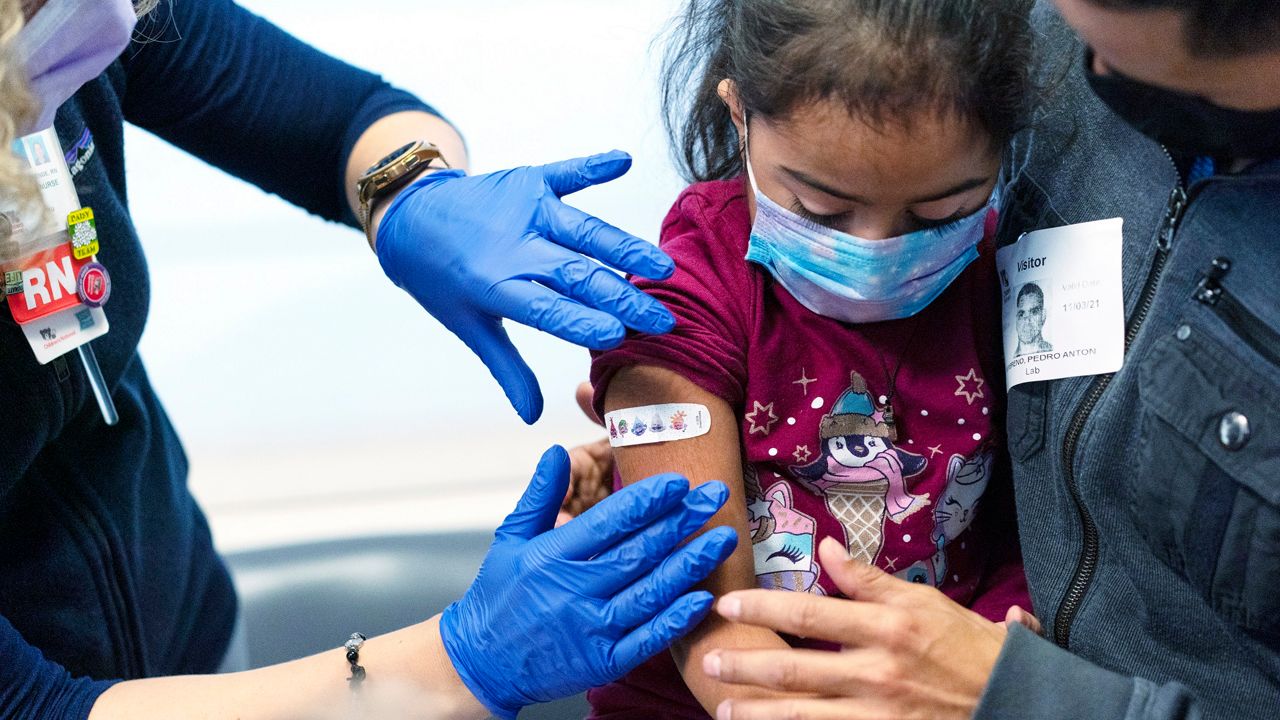MILWAUKEE — It’s been almost a year since the COVID-19 vaccines started rolling out to change the pandemic game. And now, for the first time, young kids are eligible to start getting their shots.
What You Need To Know
- The FDA and CDC gave the green light for kids aged 5 to 11 to start getting Pfizer's COVID-19 vaccine last week
- Trial data found that Pfizer's lower-dose vaccine for children was 91% effective and had no serious side effects
- Wisconsin is expecting a first shipment of around 170,000 pediatric doses, and schools are already planning onsite clinics
- Children in Wisconsin have seen the highest number of new infections in recent weeks, even though the case rates have fallen from their back-to-school highs
After multiple rounds of discussions, federal health officials gave the go-ahead Tuesday for kids aged 5 to 11 to get the Pfizer vaccine, and kids across the country — including in Wisconsin — started rolling up their sleeves soon after.
“The pandemic has been tough on everyone, but I know it has been especially hard for our kids,” Gov. Tony Evers said in a statement Wednesday. “Now, with a COVID-19 vaccine available to nearly all school-aged children, we can do more to protect our kids from this virus.”
Here, we unpack the latest vaccine news for kids — and the current status of the pandemic for Wisconsin’s young residents.
How does the vaccine stack up for younger kids?
It took some time for Pfizer’s trial data to make its way through the review process. But federal health officials finally concluded this week that the vaccine was safe and effective for kids in the 5 to 11 age range.
“Together, with science leading the charge, we have taken another important step forward in our nation’s fight against the virus that causes COVID-19,” CDC Director Dr. Rochelle Walensky said in a statement Tuesday night. “We know millions of parents are eager to get their children vaccinated and with this decision, we now have recommended that about 28 million children receive a COVID-19 vaccine.”
The FDA authorized Pfizer’s shots for this age group last week, following the advice from its panel of expert advisers. But the CDC had to check out the data too before the vaccines could go out.
The CDC’s expert panel voted unanimously on Tuesday to recommend the vaccines for kids, passing the baton over to Walensky — who supported their decision to let shots start rolling out across the country.
The vaccines for kids also come in two doses, given three weeks apart. But the doses are smaller — one-third the size of the adult versions — packaged in vials with a special orange cap.
The Moderna and Johnson & Johnson vaccines are not yet approved for kids or adolescents.
According to data from Pfizer’s clinical trials, the shots were around 91% effective for kids in this age group. That’s pretty close to the efficacy rate from adult trials, which sat at around 95%.
And in addition to keeping kids safe, health officials emphasized that vaccinating younger people also helps slow down transmission for everyone.
“It’s also to protect our community,” Dr. Ben Weston, Milwaukee County’s chief health policy adviser, said at a briefing Tuesday. “Kids do not live in isolation. They are consistently exposed to teachers, to family members, to neighbors.”
If these younger kids get vaccinated at similar rates to adolescents, CDC researchers predicted that they could help cut COVID-19 transmission by around 8% — as well as slowing down the emergence of new viral variants.
What side effects should kids expect?
Out of more than 3,000 children who got the vaccines in the trial, none of them experienced serious side effects, according to Pfizer’s research. Kids in this age group faced side effects similar to what we’ve seen in older adolescents — like a sore arm and fever.
A lot of the discussion for the CDC panel focused on the potential risks of myocarditis, an inflammation of the heart that has shown up very rarely after the mRNA vaccine.
Pediatrician Dr. Matt Oster of the CDC told the panel that most patients who developed myocarditis after the vaccine recovered quickly and had mild symptoms. He added that the risk of myocarditis in this younger age group is expected to be even lower than in the adolescents who have already been getting their shots — and much lower than the risk from actually catching the virus.
“Getting COVID is much riskier to the heart,” Oster said.
What will the rollout look like in Wisconsin?
Wisconsin is kicking off its rollout with around 170,000 doses from the federal government, according to the DHS.
More shots will roll into the state soon, as the federal government said the vaccination program would be “at full strength” next week.

The Badger State has a “deep bench” of different vaccinators who can help get this younger age group covered, state epidemiologist Dr. Ryan Westergaard said at a DHS briefing this week. Everyone from pediatricians to pharmacists to local health departments is prepared to pitch in, he said.
But vaccinating kids can be a bit more complex than adults — “meaning that children cry,” Milwaukee Health Commissioner Kirsten Johnson said at a recent briefing.
For this age group, it might make more sense to lean on settings where children already feel safe — like schools and doctor’s offices — instead of mass vaccination clinics, she said.
Madison-area schools are planning onsite clinics, and seeing their spots fill up quickly. Milwaukee’s health department is also planning after-school vaccine clinics for students and other community members.
How are Wisconsin’s kids faring?
Even as kids have seen their infection rates fall since the back-to-school peaks, children under 18 have had the highest case numbers out of any age group in recent weeks, according to DHS data.
The under-18 crowd has the second-highest total infection numbers over the course of the pandemic — right behind the 25 to 34 age range, the DHS reports.
According to data from Milwaukee Public Schools, around 1,500 students in the district have tested positive since July. The case numbers have been falling, though: The most recent week of data saw 58 students infected, almost four times lower than at the end of September.
On average, young kids tend to face milder versions of the disease. But some of them still get very sick, face long-haul symptoms, or experience MIS-C — a rare, but serious inflammatory condition that can show up in the aftermath of a COVID-19 infection.
“We shouldn’t trivialize how dangerous COVID-19 can be for children, even though most of the time, cases are mild,” Westergaard said.
In Wisconsin, around 600 kids, 9 years or younger, have landed in the hospital with COVID-19, and 20 have ended up in intensive care, according to DHS data.
More than 120 children in the state have been diagnosed with MIS-C, the DHS reports, with an average age of 8 years old. Black and Hispanic kids have faced the highest rates of MIS-C.
No Wisconsin kids have died of COVID-19. But across the country, at least 94 children in the 5 to 11 age range have died from the disease, according to CDC data.
“I really am doing this to prevent No. 95,” said one member of the CDC panel after voting to recommend the vaccines for kids. “The 95th death.”
And many more kids have had their lives disrupted by the pandemic. School closures, isolation and the loss of loved ones have all taken a big toll on young people’s mental health.
Health officials said the vaccine rollout could help kids get back to doing more of what they love.
“They’ve paid a price during this pandemic,” Weston said. “And they’re excited to move forward.”



